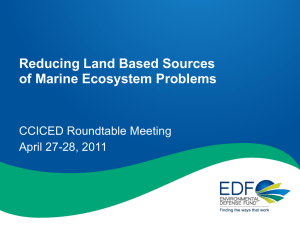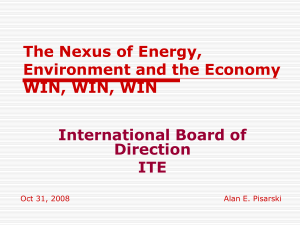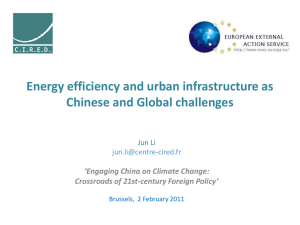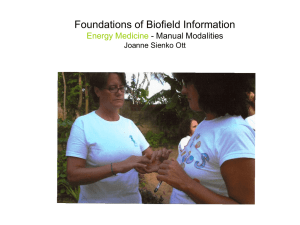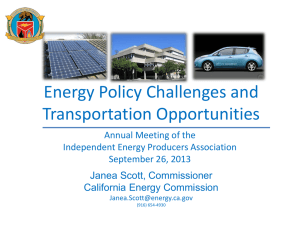are here
advertisement
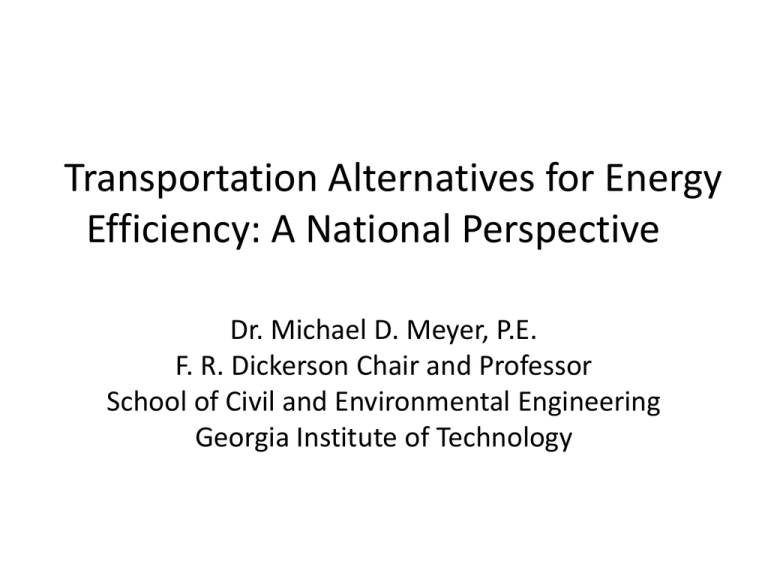
Transportation Alternatives for Energy Efficiency: A National Perspective Dr. Michael D. Meyer, P.E. F. R. Dickerson Chair and Professor School of Civil and Environmental Engineering Georgia Institute of Technology Transportation System Planning and Design Construction and Maintenance Practices Transportation System Management and Operations Vehicle and Fuel Policies Transportation Planning and Funding Land Use Codes, Regulations, and other Policies Taxation and Pricing Travel Demand Management Strategy Name Key Deployment Assumptions Transportation System Planning, Funding, and Design % Fuel/GHG Reduction in 2030 Highways Capacity Expansion Bottleneck Relief HOV Lanes 25 – 100% increase in economically justified investments over current levels 0.07 – 0.29% [0.25 – 0.96%] Improve top 100 to 200 bottlenecks nationwide by 2030 0.05 – 0.21 [0.29 – 0.66%] Convert all existing HOV lanes to 24-hour operation 0.02% 0.00% Convert off-peak direction general purpose lane to reversible HOV lane on congested freeways Construct new HOV lanes on all urban freeways Truck-only Toll Lanes Constructed to serve 10 – 40% of VMT in large/high density urban areas 0.07 – 0.18% 0.05% 0.03 – 0.15% Transit Urban FixedGuideway Transit High-Speed Intercity Rail Expansion rate of 2.4 – 4.7% annually 4 – 11 new HSR corridors 0.17 – 0.65% 0.09 – 0.18% Strategy Name Key Deployment Assumptions Transportation System Planning, Funding, and Design % Fuel/GHG Reduction in 2030 Non-motorized Pedestrian Improvements Pedestrian improvements implemented near business districts, schools, transit stations 0.10 – 0.31% Bicycle Improvements Comprehensive bicycle infrastructure implemented in moderate to high-density urban neighborhoods 0.09 – 0.28% Aspiration estimates of potential truck-rail diversion resulting from major program of rail infrastructure investments 0.01 – 0.22% Freight Rail Freight Infrastructure Ports and Marine Infrastructure & Operations Land and marine-side operational improvements at container ports 0.01 – 0.02% Strategy Name Key Deployment Assumptions Transportation System Planning, Funding, and Design Construction and Maintenance Practices Construction Materials Other Transportation Agency Activities Fly-ash cement and warm-mix asphalt used in highway construction throughout U.S. Alternative fuel DOT fleet vehicles, LEEDcertified DOT buildings % Fuel/GHG Reduction in 2030 0.7 – 0.8% 0.1% Transportation System Management and Operations Traffic Management Ramp Metering Incident Management Deployment of traffic management strategies on freeways and arterials at rate of 700 to 1,400 miles/year nationwide, in locations of greatest congestion 0.07 – 0.08% [0.89 – 1.3%] Centrally controlled 0.01% [0.12 – 0.22%] Detection and response, including coordination through traffic management center 0.02 – 0.03% [0.24 – 0.34%] Strategy Name Key Deployment Assumptions Transportation System Planning, Funding, and Design Transportation System Management and Operations % Fuel/GHG Reduction in 2030 Signal Control Management Upgrade to closed loop or traffic adaptive system 0.00% [0.01 – 0.10%] Active Traffic Management Speed harmonization, lane control, queue warning, hard shoulder running 0.01 – 0.02% [0.24 – 0.29%] Multiple strategies 0.01 – 0.02% [0.24 – 0.29%] 511, DOT website, personalized information 0.00% [0.02 – 0.07%] Integrated Corridor Management Real-Time Traffic Information Transit Service Fare Reductions Improved Headways and LOS Intercity passenger rail service expansion Intercity bus service expansion 25 – 50% fare reduction (2); 50% fare reduction (5) 0.02 – 0.09% 0.3% 10 – 30% improvement in travel speeds through infrastructure/ops strategies 0.05 – 0.10% Increase service (min: add 40% to off-peak; max: also add 10% to peak) 0.2 – 0.6% Min: increase federal capital/operating assistance 5% annually vs. trend; Max: Double fed operating assistance then increase 10% annually 0.05 – 0.11% 3% annual expansion in intercity bus service 0.06% Strategy Name Key Deployment Assumptions Transportation System Planning, Funding, and Design % Fuel/GHG Reduction in 2030 Truck Operations Truck Idling Reduction 30 – 100% of truck stops allow trucks to plug in for local power 0.02 – 0.06% 26 – 100% of sleeper cabs with onboard idle reduction technology 0.09 – 0.28% Truck Size and Weight Limits Allow heavy/long trucks for drayage and non-interstate natural resources hauls 0.03% Urban Consolidation Centers Consolidation centers established on periphery of large urbanized areas; permitting of urban deliveries to require consolidation 0.01% Reduced Speed Limits 55 mph national speed limit 1.2 – 2.0% Strategy Name Key Deployment Assumptions Transportation System Planning, Funding, and Design Travel Demand Management Workplace TDM (general) Teleworking % Fuel/GHG Reduction in 2030 Widespread employer outreach and alternative mode support 0.1 – 0.6% Doubling of current levels 0.5 – 0.6% Minimum – 75% of government employees; Maximum – double current Compressed Work private participation (1) Requirement to Weeks offer 4/40 workweek to those whose jobs are amenable (5) 0.1 – 0.3% 2.4% Ridematching, Carpool, and Vanpool Extensive rideshare outreach and support 0.0 – 0.2% Mass Marketing Mass marketing in 50 largest urban areas 0.14% Individualized Marketing Car-Sharing Individualized marketing reaching 10 percent of population 0.14 – 0.28% Subsidies for start-up/operations 0.05 – 0.20% Missouri DOT Grasman, et al, “Alternative Energy Resources for the Missouri DOT,” Jan. 2011. Grasman, et al, “Alternative Energy Resources for the Missouri DOT,” Jan. 2011. Grasman, et al, “Alternative Energy Resources for the Missouri DOT,” Jan. 2011. Sivek and Schoettle, “Eco-Driving: Strategic, Tactical and Operational Decisions of the Driver that Improve Vehicle Fuel Economy,” UMTRI, University of Michigan, Aug. 2011. “Furthermore, increased efforts should also be directed at increasing vehicle occupancy, which has dropped by 30% from 1960. That drop, by itself, increased the energy intensity of driving per occupant by about 30%.” Sivek and Schoettle, “Eco-Driving: Strategic, Tactical and Operational Decisions of the Driver that Improve Vehicle Fuel Economy,” UMTRI, University of Michigan, Aug. 2011. MARTA Carbon Footprint Carbon Footprint of MARTA (2008) 350,000 300,000 CO2e (metric tons) Upstream Vehicle-Cycle 250,000 Upstream Fuel/Energy-Cycle Direct 200,000 150,000 100,000 50,000 0 CNG Bus Diesel Bus Paratransit Heavy Rail Non-Revenue Vehicles Facilities All “Driving and the Built Environment” (TRB, Sept 2009) 1. More compact development patterns are likely to reduce VMT. 2. The most reliable studies estimate that doubling residential density across a metropolitan area might lower household VMT by about 5 to 12 percent, and perhaps by as much as 25 percent, if coupled with higher employment concentrations, significant public transit improvements, mixed uses, and other supportive demand management measures. 3. More compact, mixed-use development can produce reductions in energy consumption and CO2 emissions both directly and indirectly. 4. Significant increases in more compact, mixed-use development result in only modest short-term reductions in energy consumption and CO2 emissions, but these reductions will grow over time. – Bottom Line: Reduction in VMT, Energy Use, and CO2 emissions from more compact, mixed-use development in the range of <1 % to 11 % by 2050. – Committee disagreed about plausibility of extent of compact development and policies needed to achieve high end estimates. 5. Promoting more compact, mixed use development on a large scale will require overcoming numerous obstacles. 6. Changes in development patterns entail other benefits and costs that have not been quantified in this study. “Moving Cooler” (ULI/CS, 2009) • Evaluated non-technology transportation strategies for (a) GHG reductions and (b) cost-effectiveness in reducing GHG • Analyzed 46 individual transportation strategies and 6 “bundles” • The 6 “bundles” of strategies: 1.Near Term/Early Results 2.Long Term/Maximum Results 3.Land Use/Transit/Non-motorized 4.System and Driver Efficiency 5.Facility Pricing 6.Low Cost • Did not analyze technology/fuel strategies (instead, technology is part of the baseline) Individual strategies achieve GHG reductions ranging from <0.5% to 4.0% cumulatively 2010-2050, compared to on-road baseline GHG • • • • • • • • • 15,186 mmt 3,361 mmt – 2,428 mmt – 2,233 mmt – 1,815 mmt – 1,445 mmt – carbon pricing equivalent to $2.71/gallon VMT fees equivalent to $2.53/gallon speed limit reductions/enforcement PAYD auto insurance (100%) eco-driving by 20% of drivers at least 90% of new urban development is compact, with high quality transit 1,241 mmt – congestion pricing fully implemented in 120 metro areas at 65 cents/mile 575 mmt - $1.2 trillion transit expansion 352 mmt – combination of 10 freight strategies SANDAG • Promote transit-oriented design (TOD) by increasing housing and job density near transit nodes. • Promote mixed use development. • Increase the connectivity of new developments, using techniques such as reducing the number of culde-sacs and increasing the number of through streets. • Integrate safe bikeways and pedestrian paths into the transportation mix and provide bicycle parking and other facilities to encourage bicycling. Summary • Transportation sector an important source of energy savings • Vehicle/fuel strategies most effective • Pricing, not surprisingly, the most effective of behavioral strategies • Systems operations…as a package • Transit….it all depends • Land use….it all depends


